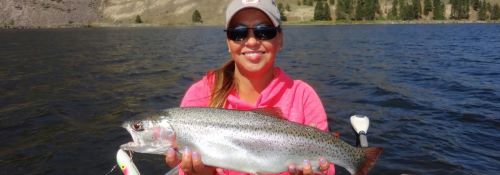British Columbia is known for many large lakes that provide incredible fishing for a wide variety of freshwater fish species. These include rainbow, bull, lake and brook trout, and kokanee. One of the most effective ways to pursue these fish is to troll for them.
Trolling is a method of fishing where one or more lines are rigged with lures or bait, and dragged through the water. There are several reasons why trolling is so effective; the two primary ones are that you can cover a lot of water to locate the fish, and you can fish significantly deeper than with other techniques.
At first, trolling can come across as intimidating, but it’s much easier than you may think. In this article, I will break down the essentials of trolling to get you catching fish in no time.
There are four areas that you need to focus upon to become proficient at trolling: equipment and gear, lure selection, where and when to find fish, and trolling techniques and speeds.
Equipment and gear
Fishing rods and reels
When shopping for your first trolling rod, I highly recommend asking your local tackle shop for assistance and recommendations. A medium-action rod with a length between 200 and 260 centimetres (6.5 and 8.5 feet) is a good all ’round option. I’d recommend a 230-centimetre (7.5-foot) Luhr Jensen Legacy Series Downrigger/Kokanee rod for lakes with fish averaging less than 50 centimetres (20 inches) in length, or the Rapala Defiant Downrigger Trolling Combo’s medium-heavy 260-centimetre (8.5-foot) rod for lakes with bigger fish like lake trout.
For reels, I prefer a baitcasting reel with a line counter. With this kind of reel, it’s much easier to let line out when trolling, and the line counter makes it easy to keep track of the distance your lure is behind the boat. It also has a better drag system for fighting bigger fish. While a spinning reel is fine to use as well, it won’t have all the features of a baitcaster.
Downriggers
While you can always use lead slip weights on your main fishing line to get your lure beneath the surface, a downrigger is almost essential when trolling bigger and deeper bodies of water. A downrigger is a device used to lower your lure precisely to a desired depth. Models of downriggers range from simple, manually operated hand-cranked units to high-performance electric models. In my opinion, any downrigger is better than no downrigger.
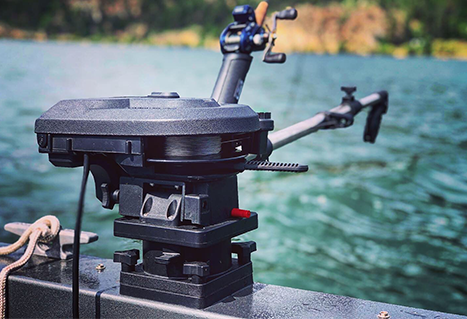
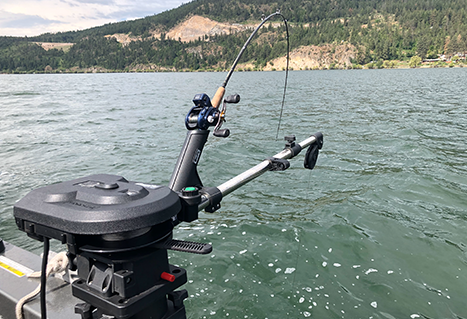
Essentially, a downrigger is composed of just four components: a large spool of braided line or wire cable; a boom; a heavy weight (known as a cannonball); and a release clip.
While it may seem awkward at first, a downrigger is simple to use.
- In your boat, attach the cannonball weight to the main cable of your downrigger (making sure the snap that holds the weight is securely closed), then carefully ease the weight into the water beside your boat, and attach your release clip on the downrigger cable just above the cannonball.
- With your lure beside the boat, let out line so it runs your preferred distance behind the boat while travelling at your desired trolling speed.
- Grab the main fishing line near your rod tip, open the spring-loaded jaws of your downrigger release clip, slip the main line between the jaws, and allow the jaws to close and hold your main line by friction.
- Place your fishing rod in the rod holder with the reel drag loosened just enough to allow line out when pulled.
- Lower the cannonball with your lure attached by releasing the brake on the downrigger spool.
- Once the cannonball has reached your chosen depth, simply re-apply the brake to the spool.
- Tighten the drag on your reel, and wind your fishing line in tight enough to add a parabolic bend in your rod (but not so tight that main line releases from the downrigger clip).
When a fish strikes, the downrigger clip is supposed to release the fishing line on its own, but you may have to release the line from the clip yourself with one swift upward pull on your fishing rod.
Sonar/fish finder
Using sonar will significantly increase your odds of locating fish. Since almost any sonar unit is better than none, you don’t need to break the bank when purchasing your first one. A few essential features that I would recommend are a thermometer to read the surface temperature; a dual-frequency transducer that provides low and high options; GPS to monitor trolling speed; and a chartplotter to set waypoints so that you can return to good fishing spots. You can find sonars with these components (like the Garmin Striker Series) for less than $300.
Lure selection
When choosing lures, try to mimic what the fish are feeding on. In most larger lakes, trout feed on kokanee, other juvenile bait fish, and sometimes salmon fry. Apex Hot Spot and Gibbs high-action trolling lures, Lyman or Tomic plugs, spoons, and dodgers or flashers with hoochies are all proven options. Having a variety of sizes and colours is essential. Three- to four-inch lures are the most common, but if the trout are foraging on salmon fry, try a smaller two-inch lure. Follow this old adage: brighter colours on sunny days, and darker colours on cloudy days. And if you’re not catching fish, keep changing lures until you find something that does.
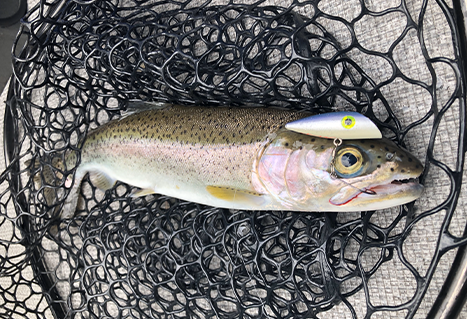
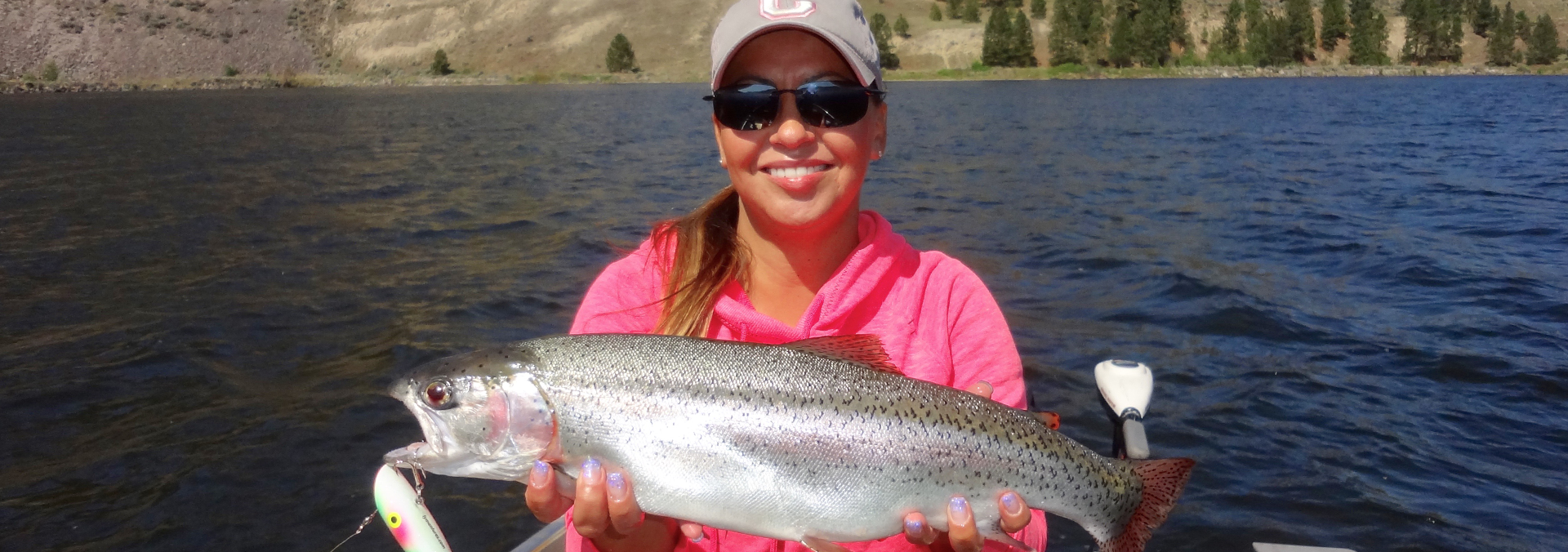
Where and when to find fish
When you approach a large lake for the first time and don’t know where to start fishing, break the lake into sections. Scan areas both visually and via sonar; look for structure like shoals, drop-offs, islands, and tributary inlets. These areas all provide good ambush points for trout, and typically provide some food source. Trout prefer water temperatures between 13° and 18°C (55° to 65°F). In summer, water temperatures will increase, driving the fish to deeper water near a lake’s thermocline. Kokanee tend to become stacked on this band of water, and the trout will be found feeding in these zones. During cooler periods, trout can be found feeding on insects and small bait fish along the shoals of a lake.
Seasonal guide to locating trout
- Spring: The water is cooler, and trout move easily throughout the lake. Find trout near the surface and along shorelines.
- Summer: The warmer water will drive fish deeper to seek cooler temperatures. This is a great time to use your downrigger, and fish will be much easier to identify on your sonar.
- Fall: Trout become extremely active in preparation for winter. They will be found higher in the water column and near creek mouths as they forage on spawning kokanee.
- Winter: Without the limitations of warm water temperatures, trout can move freely and will scatter throughout the lake. Find fish on the surface and throughout the water column.
Trolling techniques and speed
You can use a few trolling techniques to stack the odds in your favour.
Instead of trolling in straight lines, try making large “S” patterns. This technique will present your lures with a variation of speeds (speeding up on the outside of the turn, and slowing on the inside) and changes in action, which can trigger fish to strike. If you find you’re getting more strikes as your lure speeds up on the outside of a turn, then increase your trolling speeds; conversely, slow down with more strikes on inside turns.
Periodically alternate your trolling speeds. This technique will induce an erratic action in your presentation, which can provoke a fish to attack your lure.
Trolling speeds can be somewhat of a controversial topic amongst anglers. It really comes down to a few variables like the time of year, lure, species of fish, and what the fish may want. Typical trolling speeds vary from 2.4 to four kph (1.5 to 2.5 mph) for trout, and 1.9 to 2.9 kph (1.2 to 1.8 mph) for kokanee. However, when trolling plugs or bucktail lures, you can speed up to as much as 5.6 kph (3.5 mph).
In winter or early spring, when water temperatures are colder, slower speeds tend to work better. During shoulder seasons like mid-spring and fall, trout will come out of their dormant states and attack a faster presentation. In summer, when fish are seeking refuge in cooler, deeper water, trout want to conserve energy and not chase down a fast-moving lure. Ultimately, try different speeds until you get strikes, and then adjust.
To become a successful angler on B.C.’s larger lakes, you can’t beat spending more time fishing. The more you fish, the more you will learn. Each fishery has its own characteristics and challenges that you must adapt your fishing techniques to – and that’s what makes fishing so much fun!
Author: Danny Coyne. Danny is an avid angler and runs the popular fishing website BCFishn’. You can follow BCFishn’ on Instagram and Facebook.
